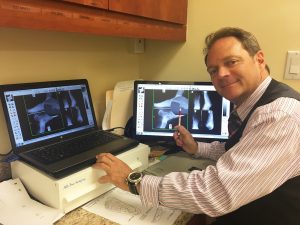You know that nagging pain in your heel? It could be a heel spur!
A heel spur, also known as a calcaneal spur, develops as an abnormal growth of the heel bone when calcium deposits form a bony protrusion on the underside of the heel.
Although heel spurs are often painless, they can sometimes cause extreme pain in the rearfoot, especially while standing or walking. They are frequently associated with plantar fasciitis, a painful inflammation of the fibrous band of connective tissue that runs along the bottom of the foot and connects the heel bone to the ball of the foot.
Heel spurs develop as an abnormal growth in the heel bone due to calcium deposits that form when the plantar fascia pulls away from the heel — a process that usually occurs over a period of many months. Heel spurs are especially common among athletes whose activities include large amounts of running and jumping. Additionally, women have a significantly greater risk for heel spurs due to their footwear.
The pain caused by heel spurs is often worst when you first arise in the morning and get to your feet. You may also experience intermittent or chronic pain during physical activates such as walking, jogging, or running if inflammation develops at the point of the spur formation. The discomfort caused by heel spurs can often feel as though it has lessened over a period of activity only to return later.
If you believe you are suffering from a heel spur, it is more than likely that you are suffering from at least one of these symptoms:
5 Reasons Your Foot Pain Could Be a Heel Spur
- You can actually feel a small growth of bone around your heel.
- You notice that your heel has come red and swollen.
- You experience pain located in the front portion of your heel.
- You experience a sharp pain in bottom of their feet in the morning that later dulls throughout the day.
- You begin to develop knee, back, hip or ankle pain in conjunction with your heel pain.
At Delray Beach Podiatry, Dr. Ian S. Goldbaum, a podiatric physician and surgeon with over 30 years of experience, has treated countless heel spurs throughout his tenure in medicine. His recommended treatments for heel spurs and associated conditions include, but are not limited to: exercise, custom-made orthotics, anti-inflammatory medications, and cortisone injections.
In the end, more than 90 percent of people get better with nonsurgical treatments. However, if conservative treatment fails to treat symptoms of heel spurs after a period of 9 to 12 months, surgery may be necessary to relieve pain and restore mobility.
If you live in South Florida and have had persistent heel pain for over a month, please see our contact information below.
—
Follow Dr. Goldbaum on Twitter @Delray_Podiatry
The content on this website is for informational purposes only. Do not rely or act upon information from www.DelrayBeachPodiatry.com without seeking professional medical advice. If you live in South Florida and would like a consultation with Dr. Ian Goldbaum, a podiatric physician and surgeon with over 30 years of experience, please see our contact information below:
DELRAY BEACH
16244 S. Military Trail #290, Delray Beach, FL 33484
561-499-0033
BOCA RATON
2900 N. Military Trail #210, Boca Raton, FL 33431 (SOUTH BLDG)
561-499-2683
BOYNTON BEACH
8198 Jog Road #100, Boynton Beach, FL 33472
561-736-4002

No responses yet